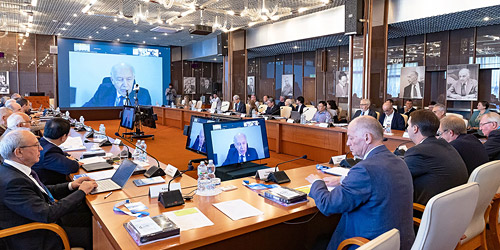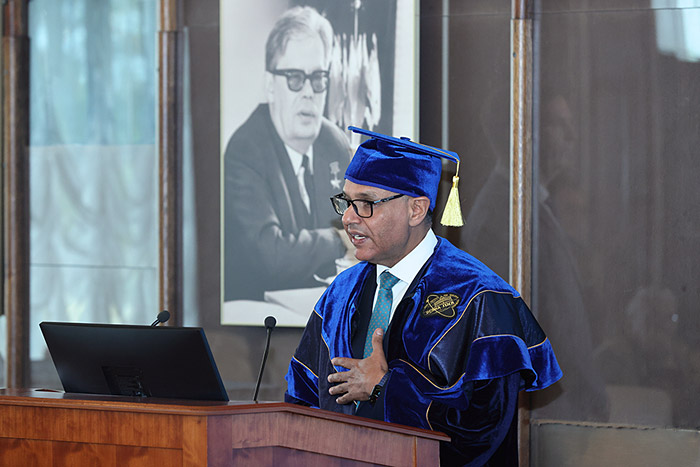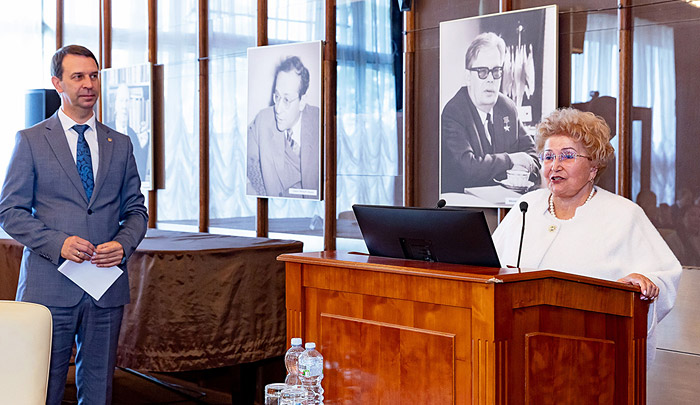
Electronic english version since 2022 |
The newspaper was founded in November 1957
| |
|
Number 37 (4785) |
At the session of the Scientific Council
Results, plans, new projects
The 138th session of the Scientific Council of the Joint Institute for Nuclear Research was held on 15-16 September at the International Conference Hall. The results of the Institute's activities were presented, new ideas were discussed, the Topical Plan for 2026 was approved and elections, appointments and awards were held.

The meeting was opened by JINR Director Grigory Trubnikov. His report presented the decisions of the March meeting of the Committee of Plenipotentiary Representatives of the Governments of JINR Member States, the results of the Seven-Year Plan for Development of JINR in 2024-2030, the progress of projects included in the Topical Plan for 2025 and developments in the Institute's scientific activities and international cooperation.
Following his address, the members of the Scientific Council congratulated Trubnikov on his election as JINR Director for a second five-year term that will begin on 1 January, 2026.
Following the report, questions were asked during the discussion. M.Spiro inquired about collaboration with CERN. R.Tsenov asked about the 2025 budget deficit, the new Life Sciences Committee and beam collisions at the NICA complex. Zhao Hongwei inquired about the progress of preparations for experiments at the NICA collider. Ch.Stoyanov inquired about the status of the applied project "Energy-transmutation". A.M.Cetto's question concerned the development of research infrastructure on Lake Baikal and the International Science and Technology Park.
Chairman of the PAC for Particle Physics I. Tserruya, Chairman of the PAC for Nuclear Physics V. V. Nesvizhevsky and Chairman of the PAC for Condensed Matter Physics D.L.Nagy presented the recommendations developed at the June 2025 PAC sessions.
The members of the Scientific Council, as stated in the final resolution, endorsed the JINR Directorate's comprehensive work to strengthen partnerships with JINR Member States and Associate Members, as well as new scientific contacts with France, Mexico and Japan. They emphasized the development of cooperation with Latin America, in particular, the signing of a Memorandum of Understanding between JINR and the Ministry of Science, Technology and Innovation of the Federative Republic of Brazil (MCTI) and the extension of the cooperation agreement between the Republic of Cuba and JINR. They also approved the signing of an agreement on scientific and technical cooperation between JINR and the Academy of Sciences of the Republic of Uzbekistan. Two new projects were positively adopted: the establishment of a "Joint laboratory of accelerator technologies and applications" in Vietnam and development of a "New facility at the WWR-K research reactor" in Kazakhstan.
JINR's scientific achievements were highly praised.
Regarding the NICA megascience project. The achievements included collider commissioning, completion of the Nuclotron rapid extraction system and the beamline assembly "Nuclotron-Collider", assembly and testing of the collider's cryomagnetic system, installation of 40 Hall sensors in the MPD solenoid and development of a thermal insulation system for the solenoid's current lead, preparation of the BM@N facility for new experiments, progress in the design of the SPD experiment's engineering infrastructure and the fabrication of detector prototypes, development of the ARIADNA collaboration and its research programme and JINR's contribution to CERN collaborations at the Large Hadron Collider.
The Neutrino Programme. Progress is made in developing the Baikal-GVD deep-sea neutrino telescope. The telescope currently consists of 14 clusters and the underwater structure contains nearly 4,300 optical modules. The onshore and research infrastructure is developed, including a control centre, laboratories, workshops and comfortable living quarters. Experiments progress successfully at the Kalinin Nuclear Power Plant, the JUNO reactor neutrino experiment and in applied research to develop new proprietary technologies.
Within the framework of the DRIBs-III project. Experiments have been implemented in collaboration with the Institute of Modern Physics of the Chinese Academy of Sciences to study the volatility and adsorption of the superheavy elements copernicium and flerovium, produced in the 48Ca + 242Pu fusion reaction, on a gold surface. The Superheavy Element Factory develops fast: a new 28 GHz ECR source is currently installed and commissioned and work is underway to certify the experimental halls for Class I radiation protection. Commissioning work on the upgraded U-400M accelerator and the development of the new DC-140 accelerator complex for applied research have been completed and the construction of a new experimental building for the U-400R accelerator complex is underway.
The work of the Bogolyubov Laboratory of Theoretical Physics was recognized as successful, particularly, the investigations "Manifestation of triple clustering in the binary spontaneous fission of 252Cf" and "Strong Kitaev interaction in BaCo2(AsO4)2", mentioned in Director's report.
The IBR-2 user programme has been resumed and widely develops, both cryogenic neutron moderators at IBR-2 operate stably, research areas are developed and a conceptual design for a new promising pulsed neutron source at FLNP is developed.
The JINR Multifunctional Information and Computing Complex, including the Govorun supercomputer, develops successfully, the computing power and performance of the Tier1 grid segment have been increased and dedicated data storage facilities for the MPD and SPD experiments have been commissioned.
Within the JINR Digital Ecosystem, institute-wide digital services are expanded: populating the JINR staff publication repository and integrating it with the PIN2 system, developing an information system for distance learning and knowledge assessment on radiation safety and more.
The development of a fundamentally new radiobiological approach to increasing the biological efficiency of radiopharmaceuticals used in nuclear medicine was highlighted, as were advances in numerical simulation of radiation safety and future radiobiological experiments using heavy ion beams at the NICA complex and the successful implementation of a scientific programme on radiation research in the field of life sciences.
The active work of the JINR University Centre and the effectiveness of JINR's international educational programmes, as well as the launch and dynamic development of the journal Natural Science Review were endorsed.
The new topic of beam physics, R&D and accelerator technology received support to coordinate priorities and resources, as well as to establish interlaboratory collaboration.
Grigory Trubnikov's idea, discussed at the PAC meeting with JINR Directorate, to establish an interlaboratory Scientific and Technical Advisory Committee for Life Sciences was highlighted.
The idea to facilitate the development of a coordinated and synchronized programme in this area was adopted. The JINR Topical Plan for 2026 was approved.
In the scientific part of the session, Director of the Institute of Plasma Physics of the Chinese Academy of Sciences Professor Yuntao Song presented a report on "The Institute of Plasma Physics of the Chinese Academy of Sciences: research and prospects" and Professor H.Jadambaa (GSI, Germany) gave a review on "How beautiful is the landscape of superheavy nuclei?!" Young scientists, recommended by the Programme Advisory Committees, presented reports including "Dilepton measurements in the MPD experiment at NICA" by S.P.Rode (VBLHEP), "Low-Energy properties of nobelium" by M.A.Mardyban (BLTP) and "Automated segmentation of pores and cracks in neutron, synchrotron and X-Ray tomography data using the UNet3+ ultra-precise neural network" by B.A.Bakirov (FLNP).
Elections were held, resulting in G.Kaminsky and A.V.Karpov being confirmed as Deputy Directors of the Flerov Laboratory of Nuclear Reactions until the end of the term of FLNR Director S.I.Sidorchuk.
By decision of the Scientific Council, Deputy Director for Research at the Institute for Nuclear Research of the Russian Academy of Sciences G.I.Rubtsov (Russia) and Professor at the A. Alikhanyan National Scientific Laboratory G.G.Mkrtchyan (Armenia) were appointed to the PAC for Particle Physics for a three-year term.
At the session, the jury announced its decision to award the OGANESSON Prize to Chairman of the Earth-Humanity Coalition and former President of the International Union of Pure and Applied Physics (IUPAP) M.Spiro; to Director of the Institute of Chemistry and Problems of Sustainable Development at the D.I.Mendeleev University of Chemical Technology of Russia and Academician of the Russian Academy of Sciences N.P.Tarasova; to Director of the Institute for System Programming and Academician of the Russian Academy of Sciences A.I.Avetisyan and to the chief researcher at the Department of Theoretical Physics of the P.N.Lebedev Physical Institute A.M.Semikhatov.
The title "Honorary Doctor of JINR" was awarded to E.Tomasi-Gustafsson (France) for her contribution to the development of spin physics and hadron structure physics at JINR, as well as to strengthening the Institute's international cooperation and to S.Harutyunyan (Armenia) for his contribution to developing JINR's collaboration with scientific and educational organizations in the Republic of Armenia.
The former President of the Egyptian Academy of Scientific Research and Technology (ASRT) and the first plenipotentiary representative of the Arab Republic of Egypt to JINR Mahmoud Sakr was ceremoniously awarded the Diploma of Honorary Doctor of the Joint Institute for Nuclear Research. He was awarded this title for his contribution to the development of fundamental science and international relations.

Mahmud Sakr
Advisor to FLNP Directorate and Coordinator of the United Nations Air Programme for Europe M.V.Frontasyeva was awarded the V.P.Dzhelepov Prize for her significant contribution to the development of an international programme for air quality evaluation using neutron activation analysis.

Grigory Trubnikov and Marina Frontasyeva
JINR Director Grogory Trubnikov and the Institute's Chief Scientific Secretary Sergey Nedelko ceremoniously awarded diplomas to the 2024 JINR Prize winners.
On 15 September, a presentation of the book "The Attraction of science - 5" by Azerbaijani journalist and writer Shirmamed Nazarli took place at the Scientists' Club. The idea to create a collection dedicated to the long-standing collaboration between the Republic of Azerbaijan and JINR came from Academician Arif Gashimov of the National Academy of Sciences of Azerbaijan. The book features essays, interviews and statistical data about Azerbaijani scientists, the special atmosphere of Dubna and the opportunities offered by the Joint Institute that provides both comfortable living and career opportunities for everyone that has chosen science as his or her life's work. At the presentation, it was suggested other communities to prepare similar publications.
The 139th session of the Scientific Council will be held on 19-20 February, 2026.
Galina MYALKOVSKAYA,
photos by Elena PUZYNINA and Igor LAPENKO